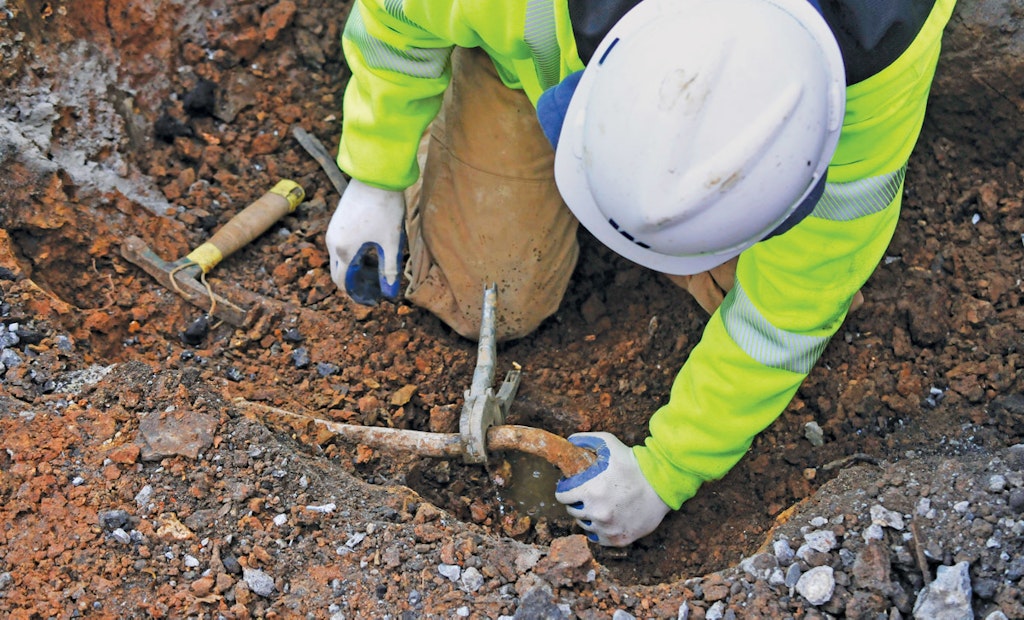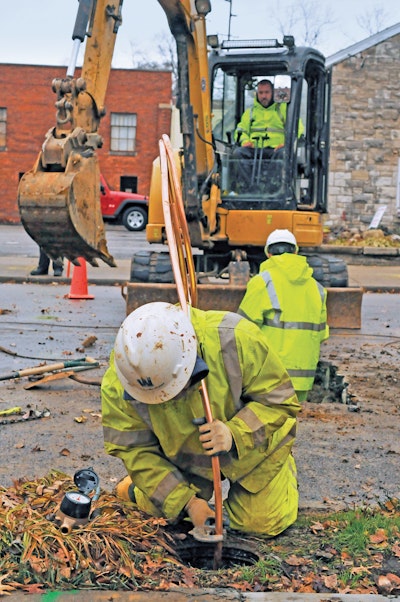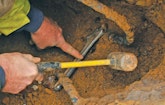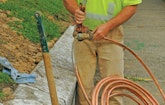
A Louisville crew member cuts an old lead service line so it can be removed and replaced with copper.
Interested in Infrastructure?
Get Infrastructure articles, news and videos right in your inbox! Sign up now.
Infrastructure + Get AlertsThere are an estimated 6.1 million lead water service lines still in use in the United States. But none of them are in Louisville, thanks to the recent completion of a long-running service-line replacement program run by the Louisville Water Co. — and completed five years ahead of schedule.
As such, Louisville is one of the first large cities in the country to successfully replace all of its known lead water service lines — 74,000 in all — with copper pipes. The original lines were installed between 1860 and 1936, when the use of lead pipes was commonplace.
The utility delivers an average of 120 million gallons of drinking water daily from the Ohio River to nearly 1 million people in metropolitan Louisville and surrounding counties, as well as thousands of businesses.
“This is a proud day for our community and our employees,” Spencer Bruce, the utility’s president and chief executive officer, noted when the replacement program concluded last July. “The work to replace the lead service lines started with company leaders who preceded me. It’s been a long road, but I’m proud to carry out their vision.”
Louisville Mayor Greg Fischer noted that removing lead pipes from the city’s water system is something that only a handful of cities have accomplished and shows how Louisville Water distinguishes itself nationally as a best-in-class water utility.
“This achievement by Louisville Water Co. is a great example of how our city innovates,” he said.
Big price tag
It cost more than $50 million and took about 50 years to replace roughly 500 miles of service lines — running from water mains up to property lines — with 3/4-inch-diameter copper pipes. The utility funded the project with municipal bonds paid off by revenue from user fees.
“The money came from our capital-projects budget,” says Jim Grunow, the utility’s former director of engineering and now director of strategic projects. “We raise our rates about 3% to 4% annually … so we never had to raise rates just to pay for replacing the lead service.”
The annual costs ranged from around $500,000 to $5 million during peak replacement years.
Before the risks of lead exposure were well known, lead pipes were widely used in water supply systems because of their malleability. In fact, the word “plumbing” derives from “plumbum,” which is the Latin word for lead.
Even after studies revealed the health risks associated with lead, the use of lead pipes, lead-based solders and lead plumbing components continued through the mid-1980s. Lead pipes and solders finally were banned from use in new plumbing systems in 1986 when Congress amended the Safe Drinking Water Act.
But cities have been slow to replace them, partly because of the exorbitant price tag — up to $30 billion, by some estimates.
Decades of work
Louisville Water started replacing lead service lines in the 1970s, either as they were discovered during routine work or while repairing service line breaks. The lead lines were concentrated primarily in older neighborhoods established before the 1930s, Grunow says.
In the ensuing years, replacement efforts escalated to replacing lines during water-main replacement projects, where any service lines connected to the mains were replaced, and then to an even more aggressive block-by-block replacement strategy that began in the 1990s.
“We would identify 100 services along a stretch of road for two or three blocks, for example, and replace all the service lines attached to the mains in those areas,” Grunow explains. “That allowed contractors to work more efficiently as well as provide us with better pricing.
“Plus we didn’t want to stay in just one neighborhood because of the inconveniences posed by construction,” he continues. “As the program progressed, the services we replaced became more spread out until it was just one or two here and there as we tied up loose ends.”
The utility used 10 different independent contractors to perform about 65% of the line replacements, but only from the water mains to property lines, Grunow notes. The other 35% was replaced by in-house crews belonging to Local Union 1683 of the American Federation of State, County and Municipal Employees, AFL-CIO.
For a brief time, the utility considered lining the lead service lines. But a pilot project performed about 12 years ago raised some concerns, so the utility stuck with its original plan to replace lines with copper pipes.
Difficulties emerge
Of course, challenges cropped up along the way, as they do with any major public works project. For example, utility officials discovered that replacing the lines would release small lead particles that could taint customers’ water.
The solution? The utility asked homeowners and businesses to flush their water systems for one hour after service lines were replaced, a process that must include opening every faucet in a home or building.
That isn’t as easy as it sounds, however, especially when customers aren’t home when the work is completed. In the end, the utility adopted a standard protocol: If property owners weren’t home when work was completed, the water to their properties would remain shut off.
In addition, inspectors would leave a postcard instructing the owners to call the utility to restore water service — and then also receive detailed flushing instructions, says Kelley Dearing-Smith, vice president of communications and marketing.
“It was a logistical nightmare at times,” she says. “But for the most part, it was effective.”
To compensate customers for running their water for an hour, the utility provided a $10 credit on their water/sewer bill, Dearing-Smith adds.
The utility also received pushback from some property owners who were concerned about the work potentially damaging frontyard gardens, retaining walls, patios and the like. In those cases, the utility accommodated property owners as best it could by using technology such as vacuum excavation, which allowed them to excavate more “surgically,” Grunow explains.
Keys to success
Several factors contributed to the program’s success. Chief among them was decades of planning and leadership from key former managers and executives, Grunow says.
“Visionary leadership at Louisville Water that dates back decades helped our lead service-line replacement program succeed,” he notes. “The leadership from our boards of directors, presidents, engineers, scientists, communicators and planners laid a foundation for water quality that continues today.
“Leadership had to be plugged in to make this project a priority,” he continues. “We’ve had multiple presidents who took up the mantle, set goals and pursued them. It all starts with leadership setting goals to get the lead out by 2025 and making the financial commitments necessary to support that goal.”
More specifically, Grunow gives credit for the program’s success to former employees like Keith Coombs, infrastructure planning manager; and John Huber, Greg Heitzman, Jim Brammell and Spencer Bruce, who each served as chief engineers and eventually as president. He also credits current employees such as Tim Kraus, chief engineer; Daniel Tegene, engineering manager; and Denise Aaron and Jamie Long, engineers, as instrumental players in achieving the long-sought milestone.
Not quite finished
Grunow says he’s proud of the utility’s milestone accomplishment, but says he can’t take much credit for it. “To be honest, I just carried out what a lot of other people started and implemented,” he says.
And while the bulk of the line replacement program now is finished, one component remains on the project’s punch-list: The replacement of about 1,800 lead service lines that run from property lines to homes and buildings, plus about 2,000 galvanized service lines that were once connected to a lead line, he says.
Property owners are responsible for replacing those lines, which generally run anywhere from 10 to 30 feet long, Grunow says.
“The galvanized lines need to be replaced, too, because they corrode, which creates scale,” he explains. “Lead particles can lodge in the scale and get released over time.”
To encourage property owners to replace their lead lines, the utility will pay 50 percent of the cost, up to $1,500. A licensed plumber must perform the work. Customers who can’t afford to pay the balance and meet certain criteria are eligible for financial assistance from the Louisville Water Foundation, a charitable, nonprofit arm of the utility.
Most line replacements typically cost less than $3,000 because they’re primarily found in older parts of the city, where yards are smaller and service lines subsequently are shorter, he says.
In some cases, the utility’s funding program will help property owners defray the cost of replacing galvanized pipes, too, Grunow says.
“We finished our part, so now we have to help residents finish their part of the job. We still have to keep encouraging them to get the lead out.”








